Geographical Distribution in Africa
Geographical Distribution of the Cabbage moth in Africa (red marked). updated on 10 July 2019. Source CABI
General Information on Pest and Damage
Introduction
The cabbage moth is common during dry cool seasons in many tropical and subtropical regions. It is an important pest in Kenya and Uganda.
Damage
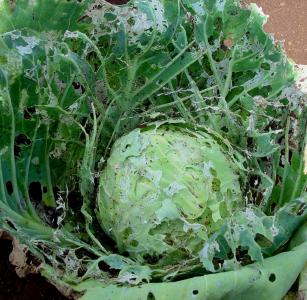 |
| Damage caused by caterpillars of the cabbage moth(Crocidolomia binotalis) |
|
© A. M. Varela, icipe
|
Young caterpillars chew off top leaf surfaces. Older caterpillars feed under a web of silk on young leaves, petioles and growing points of the plant, often damaging it entirely, by eating most of the soft tissue leaving only the ticker veins (skeletonisation). In addition to the feeding damage, host plants are often completely soiled with excrement. On cabbage the caterpillars of the cabbage moth skeletonise the outer leaves and bore into the developing head filling it with frass and excrements. Damage in the cupping stage results in either aborted or multiple heads. They cause borehole damage with frass and excrements in the developing head. Even a single mature caterpillar per plant is capable of causing economic loss to cabbage at pre- and post-heading stages.
Caterpillars nibble on the growing tip of seedlings/transplants of cauliflower causing 'blindness'. They also cause skeletonisation of outer leaves after planting and discolouration of curd. Caterpillars damage pods and eat the seeds.
On mustard caterpillars cause extensive skeletonisation of leaves and webbing of leaves and inflorescences. They also bore holes in pods eating the seeds.
On kohlrabi caterpillars cause extensive skeletonisation of leaves.
Host range
The cabbage moth is primarily a pest of brassicas and is occasionally an important pest of cabbage. Economically important hosts are cabbage, cauliflower, Chinese cabbage, broccoli, kohlrabi, radish and mustard. Wild plants like thyme, steaved tree(Crataeva religiosa), an ornamental crop (Clerodendron fragranspeniflorum) and spider flower (Cleome gynandra) are found to harbour this pest. Cabbage moth has also been recorded feeding on cotton and pigeon pea.
Affected plant stages
Flowering stage, fruiting stage, seedling stage and vegetative growing stage.
Affected plant parts
Fruits/pods, growing points, inflorescence and leaves.
Symptoms by affected plant part
Fruits/pods: internal feeding; external feeding.
Growing points: external feeding.
Inflorescence: internal feeding; external feeding; webbing.
Leaves: external feeding; abnormal forms; internal feeding; webbing.
Biology and Ecology of the Cabbage Moth
Eggs have a brown furry appearance, and are laid in batches on the lower surfaces of leaves usually close to the midrib or the veins, and arranged like roof tiles in an overlapping manner. The colour of egg mass is green on the first day turning to reddish-brown after two or three days (at the time of hatching). A large egg mass measures about 5 mm in diameter. Each female lays 75 to 300 eggs. Smooth leaf surfaces are preferred for egg laying. Eggs hatch 4 to 7 days later.
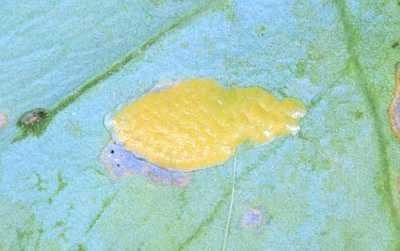 |
| Eggs of cabbage moth are laid in clusters and held together by a gelatinous glue. |
|
© Courtesy EcoPort (http://www.ecoport.org): P. Ooi
|
Caterpillars are dark green with a light brown head and dark and yellowish white light stripes along the body. These stripes are less visible when larvae are close to pupation. They measure 1.6 to 2 cm in length when fully grown. They go through five instars to pupate. Young caterpillars are often found in groups feeding near the egg mass. Older caterpillars disperse moving from plant to plant. Caterpillars actively feed for 10 to 18 days, descending into the soil to pupate.
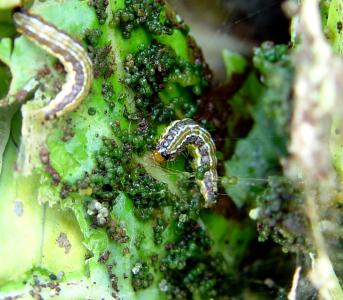 |
| Caterpillars of the cabbage moth (Crocidolomia binotalis) feeding on cabbage |
|
© A. M. Varela, icipe
|
The pupa is yellowish green when formed and turns dark brown later. Pupation takes place in a loose silken cocoon 2 to 6 cm below soil surface. Pupae are about 1 cm long. Moths emerge from pupae 10 to 15 days after pupation.
Adult moths are light brown with a wingspan of about 2 cm. Adults emerge during the night. They are weak fliers. Moths live for about 8 days.
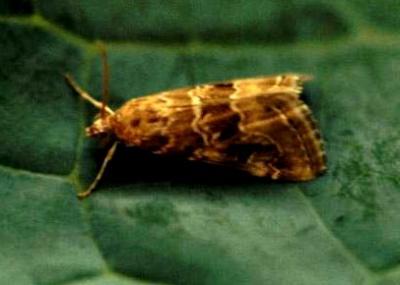 |
| The cabbage moth (Crocidolomia binotalis) |
| © A. M. Varela, icipe |
Pest and Disease Management
Pest and disease Management: General illustration of the concept of Infonet-biovision
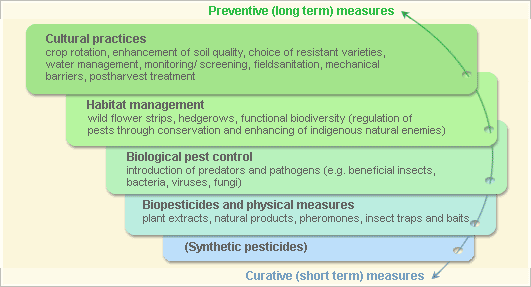

This illustration shows the methods promoted on infonet-biovision. The methods shown at the top have a long-term effect, while methods shown at the bottom have a short-term effect. In organic farming systems, methods with a long-term effect are the basis of crop production and should be of preference. On the other hand methods with a short-term effect should be used in emergencies only. On infonet we do not promote synthetic pesticides.
Further below you find concrete preventive and curative methods against Cabbage moth.
Cultural practices
Monitoring
Monitoring is very important in the first stages of the crop. Monitoring is quick, easy and effective in the initial stages of the crop, this is for approximately the first 70 days from cabbage planting (or 40 days from transplant). The cabbage moth Crocidolomiacan be detected by looking for the window-like leaf damage caused by the young caterpillars. Check the crop twice weekly in order to detect the caterpillars before they move towards the growing centre of the plant. After this time, when the cabbage plant is larger and structurally complex, it becomes too difficult to detect the caterpillars and sampling becomes much less effective.
Trap cropping
Trap cropping cabbage with Indian mustard in a planting pattern of 15 rows of cabbage followed by mustard rows has been shown to reduce attack by the looper on cabbage. Plant Indian mustard (Brassica juncea) as a trap crop between several rows of common cabbage to attract most cabbage moths and some diamondback moth (DBM) adults. Mustard attracts almost the entire population of cabbage moths and 80% of diamondback moths. Intercropping cabbage with tomato, which acts as a repellent, can also reduce attack on cabbage. The cabbage crop is planted 30 days after tomato. Remove the trap crops when these are heavily infested with the pests or else these pests will transfer to the main crop
Other important cultural practices include field sanitation, crop rotation and intercropping. Please refer to the page on diamondback moth (click to follow link) to find more information on cultural practices that can also be applied for the cabbage moth.
Biopesticides and physical methods
Bt (Bacillus thuringiensis)
For information on Bt click here.
Neem
Information Source Links
- CABI (2000 and 2005). Crop Protection Compendium, 2005 Edition. CAB International Publishing. Wallingford, UK. www.cabi.org
- Ostermann, H. and Dreyer, M. (1995). Vegetables and grain legumes. In: The Neem tree Azadirachta indica A. Juss. and other meliaceous plants sources of unique natural products for integrated pest management, industry and other purposes (1995). Edited by H. Schmutterer in collaboration with K. R. S. Ascher, M. B. Isman, M. Jacobson, C. M. Ketkar, W. Kraus, H. Rembolt, and R.C. Saxena. VCH. pp. 392-403. ISBN: 3-527-30054-6
- Rueda and Shelton. Croci or Cabbage head Caterpillar (CHC) (1995) Cornell International Institute for Food, Agriculture and Development. Global Crop Pests. Last modified 12/4/95 www.nysaes.cornell.edu
- Shepard B.M., Carner G.R., Barrion A.T., Ooi P.A.C., van den Breg H. (1999). Insects and their Natural Enemies Associated with Vegetables and Soybean in Southeast Asia.
- Varela, A. M., Seif, A., Löhr, B. (2003). A Guide to IPM in Brassicas Production in Eastern and Southern Africa. ICIPE www.icipe.org
